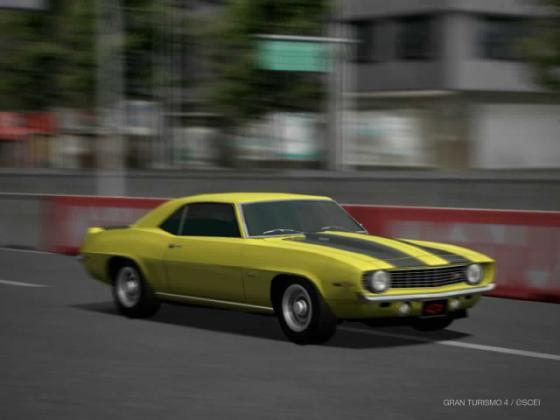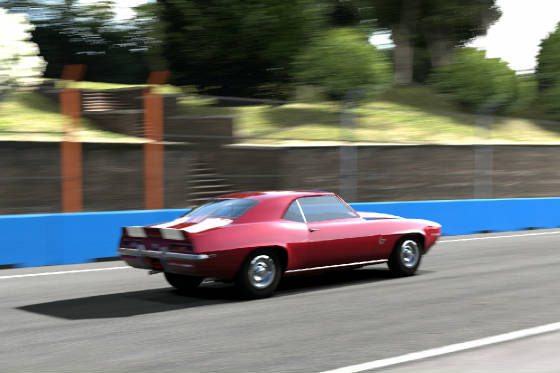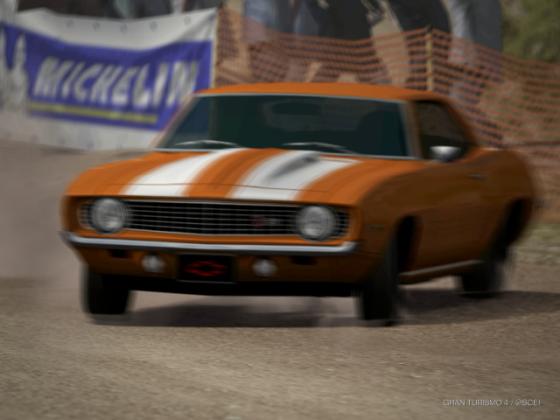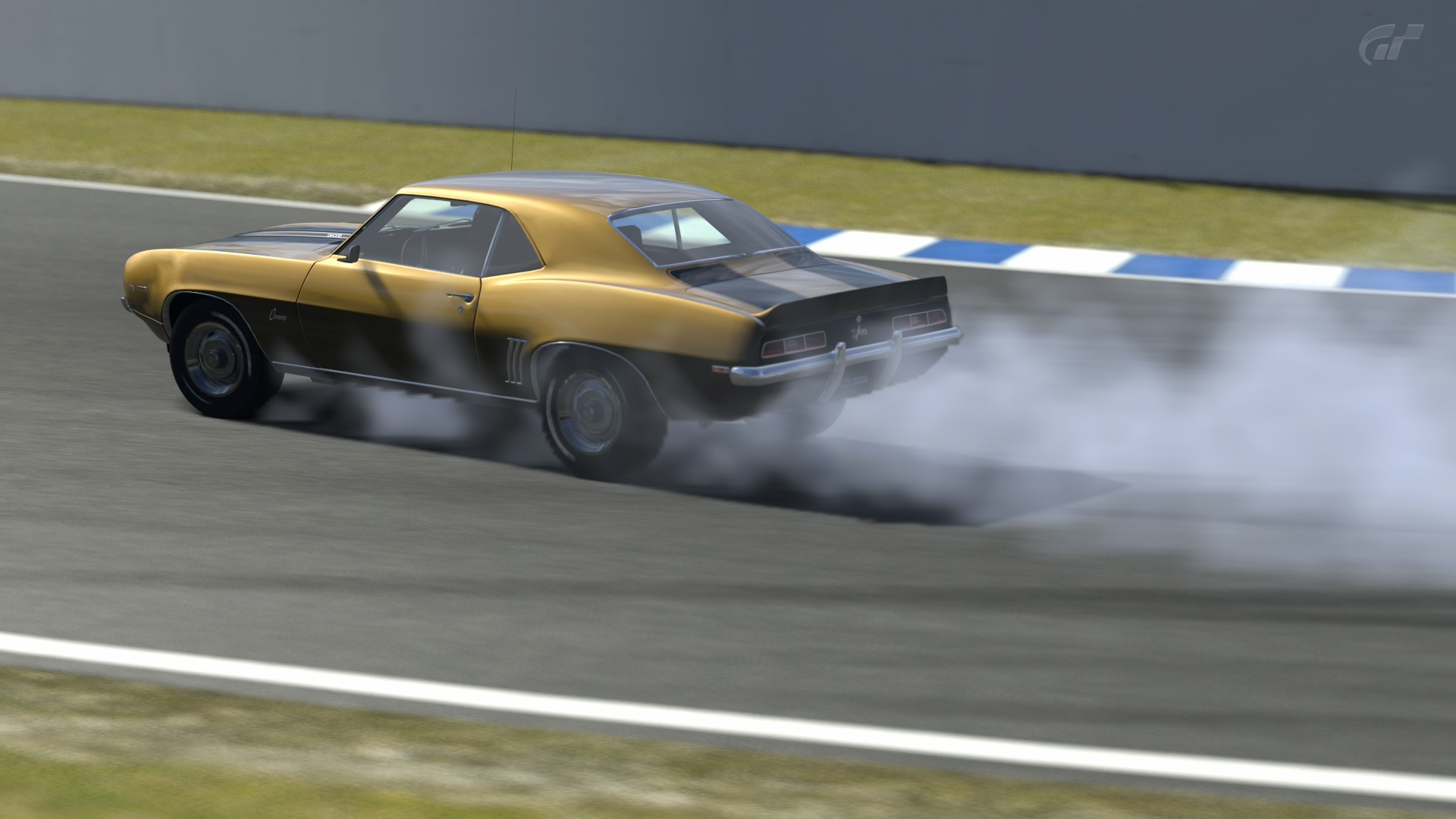|
STATS
Type: 2-door coupe
Class: Pony Car, Muscle Car
Country: USA
Host: GT2, GT4, & GT5
Price: 37,220 (GT2) 65,000 (GT4 & GT5 Z28)
Construction: steel body on frame
Length: 186" // Width: 74" // Height: 51.1"
Wheelbase: 108.1"
Overhang:
6 feet 6 inches
Track: 59.6" [F] 59.5" [R]
Weight: 3,395 lbs. (GT2 Z/28) 3,119 (GT4 Z/28)
Ground Clearance: 5.5"
Tires:
F70 x 14 front & rear
Brakes: Discs front & rear
Front Suspension: A-arms / coils / shocks / anti-roll bar
Rear
Suspension: leaf springs / live axle / shocks
Engines:
350 cubic-inch OHV V8 in Z28 (GT2), and SS model (GT4 &
5)
302 cubic-inch OHV V8 in Z28 (GT4 & 5)
Construction: iron block & heads
Aspiration: normal
Fuel Syst: 4-barrel carb.
Valves / Cylinder: 2
Bore
x Stroke: 4" x 3.48" (350 ci)
Compression Ratio: 10.25:1 (350 ci)
*The Camaros of GT4 and 5 did not have
oil change or any other maintenance performed for specs or track testing.
GT2 Tested HP: 303 @ 4,500
rpm
GT2 Torque: 380 @ 3,000
rpm
GT4 Final HP (Z28): 304 @ 5,800 rpm
GT4 Torque (Z28): ` 304
@ 4,200 rpm
GT4 Tested BHP (SS): 299 @ 4,800 rpm
GT4 Tested
Torque (SS): 380 @ 3,200 rpm
GT5 Tested HP (Z28): 281 @ 6,000 rpm
GT5 Tstd Torq (Z28): 281 @ 4,000
rpm
Credits / HP: 122.84 (GT2) // 213.81 (GT4-Z28) // 231.32 (GT5-Z28)
Pounds / HP: 11.20 (GT2) //
10.26 (GT4-Z28) // 11.13 (GT5-Z28)
Hp per Liter: 53.16 (GT2) // 61.4 (GT4-Z28) // 56.8 (GT5-Z28)
GT2 Redline: 6,500
// RPM Limit: 7,000 (Z28)
GT4 Redline: 6,000 // RPM Limit: 6,500 (Z28)
GT5 Redline: 6,000 // RPM Limit: 6,500 (Z28)
Layout:
Front Engine / Rear Drive
Transmission: 4-speed manual
Differential: limited-slip
*I used normal
tires for GT2 tests, N3 tires for GT4 tests, SH tires for GT5 tests
0-60 mph:
6.1xx
seconds (GT2 Z28)
7.350 seconds (GT4 Z28)
6.383 seconds (GT4 SS 350)
7.850 seconds (GT5 Z28)
0-100
mph:
14.6xx seconds (GT2 Z28)
14.483 seconds (GT4 Z28)
13.800 seconds (GT4 SS 350)
16.183 seconds
(GT5 Z28)
`````````````````````GT2 Z28`````````````````````````````````GT4 SS 350```
400 M: 14.813 @ 98 mph
14.747 @ 104 mph
1 KM: ```26.611 @ 119 mph
26.352 @ 120 mph
Test Track Time: 2:03.397``````````````````````````N/A
Brakes 100-zero mph:
4.25 seconds
(GT4 Z28)
4.93 seconds (GT5 Z28)
GT2 Top Speed at RPM Limit (7,000 rpms)
1st: 54 mph
2nd: 75 mph
3rd: 98 mph
4th: 128.28
mph (tach limited)
GT4 Top Speed at Redline (Z28-302)
1st: 52 mph
2nd: 72 mph
3rd: 95 mph
4th:
@129 mph@ 6,500 rpms (tach limited)
GT4 Top Speed at Redline (SS-350)
1st: 49 mph
2nd: 67 mph
3rd: 86 mph
4th: 120.xxx mph @ 6,000 rpms (tach limited)
GT5
Top Speed at Redline (Z28)
1st: 55 mph
2nd: 73 mph
3rd: 95 mph
4th: 129 mph @ 6,500 rpm (tach
limited)

------------EXTERIOR / HISTORY-------------
The Camaro was Chevy's answer to Ford's Mustang, but by the time it was released, Ford Motor Company was 2½
years ahead of General Motors (as well as American Motors and Chrysler) with their 2-door.
These sort of vehicles
were initially known as 'personal' cars, because they were designed with younger people in mind who didn't have families.
The idea was that these cars weren't totally practical...they were (instead) smaller, lighter, and eventually became
more performance-oriented, imaginative, and fun. These smaller ones (Mustangs, Camaros, Firebirds, AMC's Javelin, and
a few others) eventually became known as "pony cars" due to their wilder driving characteristics. They were more nimble than
the larger, heavier autos people were previously forced to buy, and turned out to be better for circuit racing, too.
Mustangs
sold wildly for two solid years before the Camaro appeared. And what an entrance it made to the world. At first, there
were several models, including the SS and the RS, both of which could be ordered with more options; but what was lurking in
store for the public (and the racetracks, as well) was a small-production version with the code name Z-28.
Only 609 of these were built in 1967, and they were hard to obtain since:
1}. They were equipped with a new small-block racing engine, built for higher revs than
usual. And....
2}. they were not advertized. There were no sales literature, no commercials or other forms of promotion
pushing the high-powered auto.
The only way to get a Z28 was to special-order it at the dealer; who probably sized
up his customer before making his pitch. In other words, the Z28 was advertized by word of mouth; hence, these early Camaros
were very rare even back then, and are even rarer today. Soon, the Z28 took on Ford, Mopar, and American Motors in the
showrooms, as well at the tracks. 1969 was the Camaro's winning year. The Team Penske Camaro driven by Mark Donohue won
SCCA's Trans Am for the season. Perhaps this is why we have 1969 Camaros in our game instead of earlier or later models.
By
1969, Camaro production was a bit more balanced. A total of just over 90,000 were sold that year, and of those, 19,014 were
Z28s instead of just a few hundred as in '67. By now, one could get a wide variety of engines with this car, including the
350 small-block engine featured in the '69 that's in GT2 and GT4, or a higher-revving 302 cubic-inch block (found in GT4 and
5) derived from Chevy's involvement with Trans Am racing.
The Camaro is yet another stocky, meaty muscle car--and totals 74 inches in width. Its length
is a bit short for its era: 186 inches, and the wheelbase of 108" means better stability and maneuverability when compared
with others from 1969, since there isn't as much body overhang front and rear. The Camaro is also shorter (51.1") than a lot
of American cars of the time, and its ground clearance of just 5.5" is good, too. All these facts should be taken into
account: the 1969 Camaro Z28 is one of the best-handling American cars of its time, believe it or not. Still, there
is lots of work to be done.
Firstly, weight is our biggest concern: it starts at 3,395 pounds in GT2,
and can be lowered to 2,938 with full reductions (this includes a race-kit). GT4 offers two models:
a Z28 with the 302 engine, and an SS with the 350. Polyphony Digital has goofed again: neither of these cars weighs more than
3,119 pounds. *sigh* Real-life stats tell us real Camaros from this time, and with these engines
weighed anywhere from 3,400 to 3,700 pounds. Websites vary quite a bit, but I have yet to see one that quotes as low as PD
does in GT4 & 5. The earliest Camaros from '67 and '68 model years were a bit lighter, though. Perhaps this is why PD
got confused.
Despite this screw-up, these cars still have issues. The problem isn't weight really, it's
the power-to-weight ratio, which starts at 11-ish and ‘only’ falls to the sixes with complete engine mods. Neither
of these figures is bad, but as I raced the Camaro, I found myself wishing it had maybe 50-100 more hp at times, just to compensate
for the fact that it can be difficult in corners.
Needless to say (but I'm saying it anyways), it's a good idea
to get as much weight off as can be afforded.
Though 1st-gen Camaros are good lookers...available with cool racing
stripes and a number of dazzling color schemes, they are typically unwieldy to drive, especially as power gets higher.
There are a couple good things, tho. The good news is: in GT2 this is the ONLY 60s-era muscle car that can be race-modified
with downforce if I'm not mistaken. It will also accept rally tires if you wanna take it to the dirt. In GT4, (where more
muscle cars can accept off-road capability & tires), Camaros do well at dirt tracks.
As it goes, let's have a peek under the hood.

------------------ENGINE / DRIVETRAIN------------------
All of the muscle cars in our games (American or otherwise) generally have fantastic
engines, and the 1st-gen Camaro is no exception, although immediately in my track tests I found some of my long-held
assumptions burst like the bubbles they are!
In GT2, the Z28 got to 60 mph from zero in a disappointing 6.1 seconds. 0 to
100 in 14.6. It hit the quarter-mile in 14.813 seconds at 98 mph.
The SS version in GT4 (which has the same 350 cid V8) is mildly faster. GT4 and GT5's Z28s (with their smaller 302 powerplant)
are much slower, and suffer from an incredible lack of low-end, although I shaved almost a second from my times if I
dropped the clutch at about 3,500 rpms. In either game, I found myself going less than 130 mph at the end
of a kilometer! “Why is this?” many a newby has asked.
Well it's because the Z28 (like all muscle
cars from these times) was equipped with a short-throw transmission; ready-made for quarter-mile drag racing at best! In fact, the
car only hit a paltry 128 mph tops around the Test Track, as the tachometer repeatedly pegged its RPM
limiter! You should therefore buy a racing gearbox to improve top speed. Don't even bother with close gearing or ‘sports’
gearing...
For engine upgrades, there are 3 steps of NA tuning, and GT4/5 include a supercharger
as well. Stage 3 natural power costs the most of course. Chevy has us paying just over $90,000, plus another 30 large
to get other engine mods and a better aspiration system. This all adds to a top of 439 hp (GT2) and just
over 500 for the Z28 in GT4. GT4's SS model can accept slightly more if I'm not mistaken. GT5's top natural
power (no supercharger) for a Z28 tallies up to 481 hp @ 6,900 rpm with 419 foot-pounds at 4,900,
and since the Z28 in this game is a Premium model, it'll have even more once its engine has been fully broken-in.
Like I said, this is a lot of power---but I found myself wanting more. It seems antithetical that
in such a heavy, taciturn machine you'd be craving more "go", but that was my gut reaction at first when I drove the Z28 in
GT2. But there's plenty of racing we can do with this car in later games. Just ask.
---------------------CHASSIS / HANDLING---------------
Again, we have another bad '60s-era undercarriage. Weak springs, tempermental live rear
axle, lots of understeer, and the promise of a spin-out in many tight corners are all part of the Camaro's pony-ish heritage.
Wonderful.
Make no bones about it, the first thing to get is a better suspension. Either the semi-racing
or full-racing set up will do, depending on how much power is being used. I have found sports suspensions useful for
some races (like the Muscle Car Challenge), in which everyone else is having the same issues my Z28 was. Let's discuss
this car from game to game for further insights.
GT2:
Very simple. Springs, dampers, and stabilizers can all be dialed to the mid to high range, which improves responsiveness,
lessens body roll & front-end diving. After all this, the Camaro will still (unfortunately) be quite imperfect.
Expect understeer in long turns rolling faster than 90-100 mph, and if you don't know much about sliding and countersteer,
now you're gonna get a quick lesson so take notes.
GT4:
In this game, we're burdened with about 70% understeer, but snappy oversteer and fishtailing takes
over; especially if these cars are coming out of a tight area, and the gas gets mashed with a little too much passion. The
good news is I've had better success with occasional Camaro drifting in this game.
Basic Camaros were equipped with drum brakes, or a combo of discs and drums, but the higher-powered
Z28 and SS in our games had discs on all wheels. It doesn't make any difference though, it's still necessary to take
account of longish stopping distances. The brake-controller is therefore almost mandatory for some situations.
GT5
The Camaro Z28 appears
as a "Premium" model in this game, and therefore has received a lot of attention from me. I imagine a new type of germ
that's looking as if it could cure cancer might get a little more attention from the scientists who study it, but only
a little more. ;-]
One thing I've noticed right off the bat is the Z28 now has stronger springs than it did
in GT4. GT5 = 4.0 and 3.0 kg/mm front to rear, wheras GT4 = 2.1 and 2.0 for the same car. Which game is right? I'll assume
GT5 is closer to reality. The Camaro Z28, after all, was based on its racing cousins.
The differences from GT4
to GT5 so far as understeer and oversteer are concerned don't seem that heavy at first. As I drove a beer-colored Z28 around
Autumn Ring, I noticed that: Yes, the car still understeers heavily, and it also oversteers heavily. But as lap melted
into lap and nearly an hour went by, I also noticed there definitely is a difference from GT4 to GT5. It's almost as if here
I am driving this 2-dimensional image around on my TV screen, yet I could feel each of this
car's four tires reacting differently to the pavement!
GT4 had about "70% understeer" matched with about 30%
oversteer. That's what I think I meant when I wrote that earlier article years ago. Anyways, in GT5, things feel a lot more
balanced. Now, these traits run about 50/50, assuming the driver is really pushing this car.
Understeer
isn't as immediate in GT5 it seems, when compared to GT4, even while the automobile is stock. There is a bit more of
a safety-zone one can play with before the car starts to push than there was in that previous game. Perhaps this is due to
the fact that GT5's tires only overheat (and therefore, understeer or oversteer) when pushed past their max. But when
I compare GT5's '69 Camaro Z28 to its '97 Camaro Z28 grandchild, it is obvious this latter car can be pushed to a greater
extreme before its front tires overheat, and understeer shows up.
Unfortunately, understeer isn't the only issue to
look for up there. The front-end also has a wicked habit of grabbing, especially if sports tires are equipped.
This grabby behavior is mostly felt while the driver is braking and steering at the same time. More on this subject later,
actually.
Oversteer happens much more easily and more often than it did in GT4, but notice:
it is also a lot more controllable when it does show up. The driver has a choice here.
The '69 in GT4, if its
rear got loose, was often prone to this huge loss of control...as a man walking on a tightrope suddenly loses his
balance. Often, the rear would slide out, the driver would try to counteract this, and there goes the front-end snapping back.
Now you're in a spin! The car in GT5, on the other hand, offers oversteer (slides, burnouts, drifts) to a much greater
extreme, yet the Z28 in this game feels a heck of a lot more stable overall while this is happening. The car is difficult
to pilot, true, but it is also willing to work with us a bit if we allow it some space.
There's also braking,
which I started to discuss earlier. Goodness, there's a huge difference here from earlier games, especially since we
can turn ABS off. But even when turning the Brake Balancer off, notice those brakes (especially the rear ones) can still easily
lock up. This happens easier if the Camaro is steering while braking, and magnifies significantly if it is travelling
down a hill while steering and braking all at the same time. This car's got a light trunk area, basically.
In
GT4, I noted "longish stopping distances", but had nothing to say about what happens during those stopping distances.
Perhaps this is because the Camaros in this game mostly felt stable under braking, and I probably didn't do too much trail-braking
in this game. Well in GT5, one must really give thought to braking this car, especially with ABS off. It's hard to really
write about all the difficulties the driver can face from this car in the latter game; such an essay would take paragraphs,
but here's a few tidbits.
In a straight line on a flat track, the Z28 often brakes with perfect stability,
ABS off, brake balancer off. But let's try to brake it on a track that isn't so flat, in a line that isn't so straight.
Amazingly, you will notice now that whatever tire happens to be inside will tend to lock-up first. :-] Did any of this happen
in GT4? I honestly don't remember, so probably not. Anyways, give a care while braking...
...or not! Assuming you want
this car to mis-behave, to get a little sideways even before the turn has kicked in, it will easily do so. It all starts with
those brakes! If you want a minor twitch on-entry to give the pony-like Z28 a tighter line into a hairpin, this can be done.
If you want more of a grandiose, messy slide, which follows up with a massive rooster tail of smoke on exit, the Camaro is
happy to provide.
Summary, game to game...
However you slice
it (whatever 'it' is), it's time for a wild, fun, sometimes frustrating ride with the Z28.

-------------------------PROS-----------------------
1).
Lots of power & torque. Typical small-block V8 engines (either a 302 c.i.d. or a 350, depending on game and model) that
pulls out of those lower gears like butter in a melting pot, assuming the engine is revving high enough.
2). Awesome
paint color schemes plus imaginative body work. Racing kit available in GT2 and GT5.
3). Lower suspension and stockier
body with less overhang than you'd normally find in an American coupe from this time = better maneuverability, and
less time between braking and accelerating in those corners...in theory, sometimes in practice.
4). GT4 & 5 cars
are a couple hundred pounds lighter than they should be, thanks to a mistake over at PD.
5). A higher redline than
typical for this type of auto.
6). This is the only American muscle-car that accepts off-road tires in GT2. In GT4
and 5, the Camaro may have many handling faults on pavement, but does fairly well off-road.
7). GT5: Premium model,
which means we get the interior, body mods, and functional lights & wipers. Love that wood-grain steering wheel.
8).
GT5: these V8 engines actually sound like V8 engines, even after stock parts are swapped away. The
'69 Z28 engine/exhaust sample is not shared by the '97 Z28's samples, as in previous GTs.
-------------------------CONS--------------------------
1). Top speed is horribly low
before the racing gearbox / taller gears are installed. How embarassing for Chevy.
2). Disappointing standing-start
acceleration...a real lack of low-end torque from either the 302 or 350 V8s. To do better in 1969 meant buying a giant
engine, killing some cornering advantage smaller engines provided.
3). The 350-SS of GT4 doesn't suffer as much hesitation;
has lots more low-end. Launching it properly (without excessive wheelspin) takes finesse.
4). Factory installed tires
good for drag-racing and ovals, but not for full-course racing with actual corners, despite the fact that the Z28 was rated
high in its day during SCCA's Trans Am.
5). Severe understeer above 100 mph no matter what grade of tire is
used! In GT4, low-speed understeer is also added mid-corner. Ugh.
6). Prone to spin-outs due to unreliable power delivery
(since power is packed in a higher range in these smaller V8s). THINK before you mash that gas!
7). Factory suspension
and brakes are weak and shoddy. There goes more credits back to the Polyphony Institute.
8). Pricey, somewhat. Depends
on the game, though.
9). GT4: engine samples (even the stock ones) sound poorly defined. The SS sounds better
than the Z28, but is merely a soundbyte sample shared with the newer 4th-gen Camaro. After-market exhausts in GT2 or 4 often
don't sound like V8s at all. Insulting!
10). GT5: poor visibility when driving with full cockpit view.

Originally Published: September 2nd, 2004
Edited for GT4 content: ?
Edited for GT5 content: May 15, 2011
|